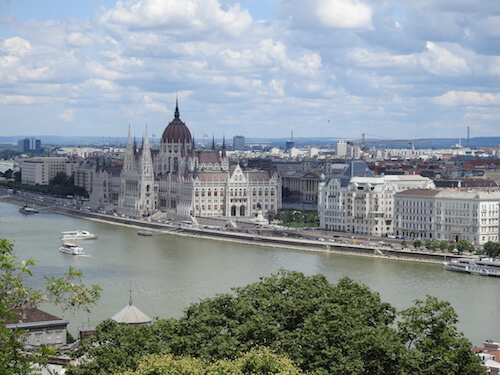 I’m standing by the side of the River Danube when I spot a sign that I recognise from the map I’ve been pouring over.
I’m standing by the side of the River Danube when I spot a sign that I recognise from the map I’ve been pouring over.
It’s the letter D written in a wavy logo, and it means I’ve found a bus stop. A boat stop, actually, and I can’t stop grinning with glee at the prospect of puttering around on the Blue Danube. Which is greeny-brown most of the time, but just as pretty as it was when Johann Strauss II composed his famous waltz.
The Hungarian language seems completely unfathomable for anyone not born to it, and it's one of the most difficult to learn, but figures are figures, and I figured out that a boat was due in 13 minutes. Just enough time to cross the road and photograph the spectacular Houses of Parliament and grab a few shots of its guards, who would look quite fierce if they weren’t wearing sexy sunglasses.
Thirteen minutes later I was puttering along the famous Danube for free, thanks to an all-encompassing transport ticket that let me jump from underground train to tram to boats for a cheaply priced week-long ticket.
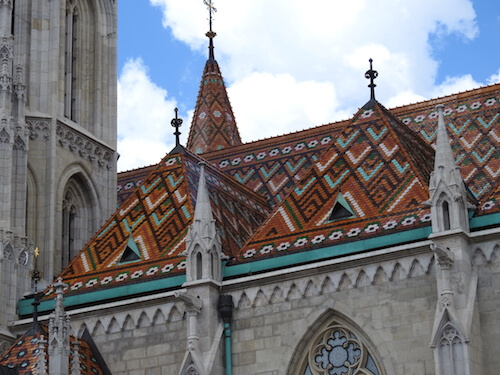 When I was a kid, Hungary was a place that nobody bothered to visit. I’m not sure you even could in those communist days when the Russians who ‘liberated it’ after the Second World War imposed a brutal and sterile communist regime.
When I was a kid, Hungary was a place that nobody bothered to visit. I’m not sure you even could in those communist days when the Russians who ‘liberated it’ after the Second World War imposed a brutal and sterile communist regime.
Those days are long gone, although some bullet holes remain in the buildings, and Hungary today has surged into democracy and capitalism to become as colourful and lively as the paprika that warms its food. Although that may be reversed under the hardline Prime Minister Viktor Orban and his right-wing Fidesz party.
For now, though, Budapest is a place that kindles the joy of travel, and this glorious city has a level of grittiness and texture that you don’t feel in uber-pristine Vienna or too-touristy Prague.
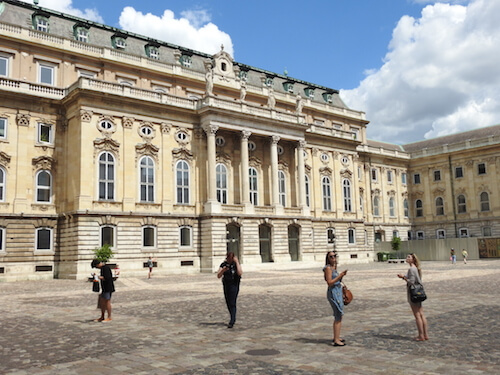 A boat trip crossing from stop to stop on either side of the Danube reveals many of its architectural splendours, but this is a city best experienced on foot. Each street tempts you tp stroll along it to admire another mighty Renaissance, Baroque or Gothic beauty, interspersed with a few dreary communist buildings that were rapidly erected to fill gaps created by wartime bombs.
A boat trip crossing from stop to stop on either side of the Danube reveals many of its architectural splendours, but this is a city best experienced on foot. Each street tempts you tp stroll along it to admire another mighty Renaissance, Baroque or Gothic beauty, interspersed with a few dreary communist buildings that were rapidly erected to fill gaps created by wartime bombs.
All I knew of the place before I went was that it’s a city of two halves: Buda, built on top of a crazy-paving of hot thermal springs and gentle slopes, and Pest, across the river on flat plains. The two are now intertwined as one with a cross-cross of bridges and tunnels, and each side gives you fabulous views of the other.
In tourist terms it’s still largely undiscovered, although visitor numbers have risen dramatically in the past three years and I fear a flood is coming. But that's nothing new. Centuries ago the place was all the rage, with pillagers and invaders surging in from every angle to leave a medley of lingering influences. You can thank the Turks for the Turkish baths, with more than half a dozen spas where you can wallow in hot springs.
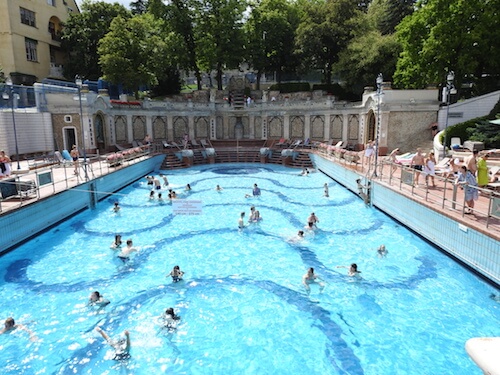 I first dipped into the Kiraly Baths, a small, unglamorous, old fashioned hothouse with am octagonal thermal pool with hot and cold baths and a steam room around it. I paid extra for a massage, and had an old Hungarian giant massage my back for 20 minutes that lasted for 30 as we bumbled along trying to communicate in English and Spanish. He wants to move to Spain to treat elderly English expats, he explained, but his own health is fading and he’d never get medical aid in a foreign country. Well, I think that's what he said, although he might have been explaining why the Danube is no longer blue, for all I know.
I first dipped into the Kiraly Baths, a small, unglamorous, old fashioned hothouse with am octagonal thermal pool with hot and cold baths and a steam room around it. I paid extra for a massage, and had an old Hungarian giant massage my back for 20 minutes that lasted for 30 as we bumbled along trying to communicate in English and Spanish. He wants to move to Spain to treat elderly English expats, he explained, but his own health is fading and he’d never get medical aid in a foreign country. Well, I think that's what he said, although he might have been explaining why the Danube is no longer blue, for all I know.
I thought Kiraly Baths were wonderful, until I paid twice the price and had four times the fun at the more upmarket Gellért Spa. That’s a complete maze or Art Nouveau over-the-topness, and if you navigate the corridors correctly you’ll find at least four thermal pools, steam rooms and saunas, hot and cold plunge pools, an indoor pool surrounded by columns and the fabulous outdoor pool. I was diligently swimming some widths when a snippet from West Side Story filled the air and the lifeguard rang a bell. I barely had time to think, “eh?” when the water heaved beneath me as a wave machine kicked in. Enormous fun! I ditched the backstroke and joined in the frolics.
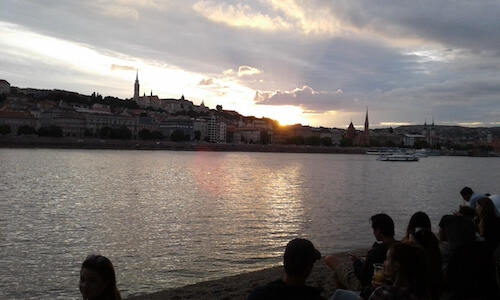 I’d reached Budapest as part of a seven-stop trip around Eastern Europe on Busabout, a brilliant service that runs a hop-on, hop off bus where you jump on in one city and get off in another later that day. A bus swings by every two days, so you can stay as long as you want, and it pulls up outside recommended hostels right in the city centres. It offers discounts on sightseeing excursions too, and the young guides organise communal suppers for anyone who doesn’t fancy eating alone that evening.
I’d reached Budapest as part of a seven-stop trip around Eastern Europe on Busabout, a brilliant service that runs a hop-on, hop off bus where you jump on in one city and get off in another later that day. A bus swings by every two days, so you can stay as long as you want, and it pulls up outside recommended hostels right in the city centres. It offers discounts on sightseeing excursions too, and the young guides organise communal suppers for anyone who doesn’t fancy eating alone that evening.
Budapest was my final stop, and I rented an apartment on the Hungarian equivalent of the Champs-Elysees for a price that makes Parisian rentals seem extortionate.
The guide on the bus had raved about the city, telling us about the ‘ruin bars’ originally set up in abandoned, bombed out buildings and now so hip that buildings are deliberately being made to look shabbier. The price of drinks can apparently ruin you, too, if you hook up with one of the stunning Hungarian girls who like to beguile the tourists.
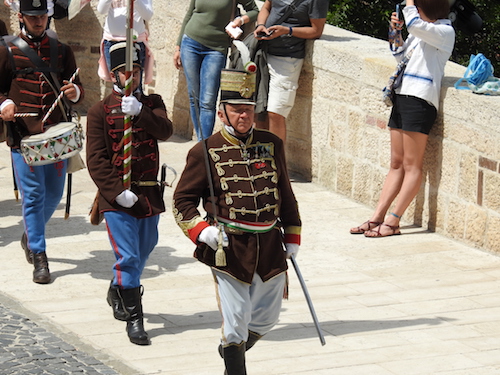 There’s a gruffness to the residents that can be mistaken for rudeness. Perhaps it is, sometimes, but it’s more likely a practicality that comes with having lived through tremendous hardship and knowing that the concept of ‘have a nice day’ is too precious to throw away cheerily on irrelevant strangers.
There’s a gruffness to the residents that can be mistaken for rudeness. Perhaps it is, sometimes, but it’s more likely a practicality that comes with having lived through tremendous hardship and knowing that the concept of ‘have a nice day’ is too precious to throw away cheerily on irrelevant strangers.
On the first night I set out in the evening heat to walk down Avenue Andrassy, passing swish stores selling Gucci and Chanel, past kebab counters and ice cream stands, past other single women strolling around in perfect ease. Buses and trams clattered past, and cyclists darted between them. The night was warm, the vibe was friendly, the smells enticing, and a giant Ferris wheel bathed in shiny silver lights shone down upon us all.
The next morning I joined a free walking tour where our enthusiastic guide delivered a potted history and left us three hours later in the magnificent castle, another fabulous monument in a city with no shortage of architectural splendours. A bike ride the next day was even more entertaining. Our guide set a cracking pace as I wobbled between traffic on cycle lanes painted ominous blood red. But no mishaps happened and soon I started laughing with the exhilaration of whizzing along the banks of the Danube. That wasn't something I’d ever been able to say before, and I whispered it to myself a few times to let the moment embed itself in my memory.
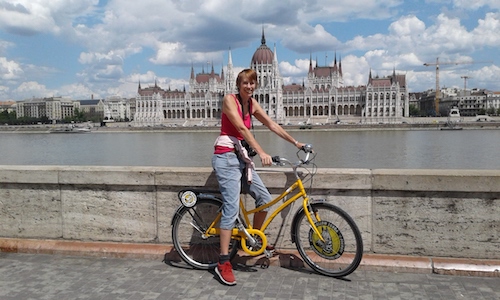 The cycle tour included a stop for strudel and coffee, although Hungarian strudel is called rétes, and is slightly different from the Austrian version with thinner pastry. The curd cheese and cherry option is even more delicious.
The cycle tour included a stop for strudel and coffee, although Hungarian strudel is called rétes, and is slightly different from the Austrian version with thinner pastry. The curd cheese and cherry option is even more delicious.
Culture abounds in this imperial city too, with at least three theatres in walking distance of my rooms. The glorious grand old Opera House was closed for a refurb, so I took myself to the Erkel Theatre instead to watch the British musical Billy Elliot sung in Hungarian with English subtitles on a screen above the stage. Music by Elton John is supported by Lee Hall’s lyrics, and what fruity lyrics they are – the Hungarian translator hadn’t held back either, judging by the laughter. I read later that there was a big kerfuffle with the conservative press demanding that the show be cancelled for gay elements that could turn a young boy’s head, which explains the 10 minutes of solid applause at the end.
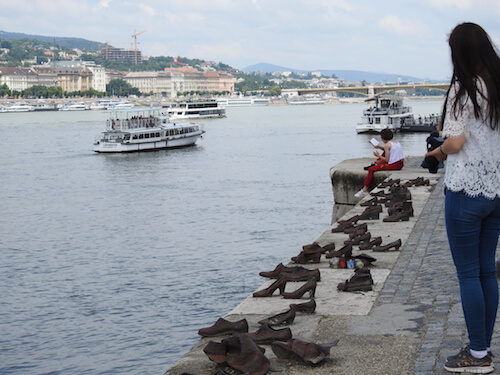 Budapest wasn't as badly scarred as its neighbouring cities and countries during the Second World War, although it certainly had its terrors. One of the most moving holocaust memorials is a simple and stunningly effective sculpture, Shoes by the Danube. It's an array of 60 pairs of old-fashioned shoes cast in iron by Gyula Pauer to remember thousands of people in 1944 and 1945 who were ordered to strip on the river bank and shot, so their bodies fell into the water and were washed away. You can't help looking down to see where they fell, and imagine the heap of bodies that must have piled up there until the river washed away the evidence.
Budapest wasn't as badly scarred as its neighbouring cities and countries during the Second World War, although it certainly had its terrors. One of the most moving holocaust memorials is a simple and stunningly effective sculpture, Shoes by the Danube. It's an array of 60 pairs of old-fashioned shoes cast in iron by Gyula Pauer to remember thousands of people in 1944 and 1945 who were ordered to strip on the river bank and shot, so their bodies fell into the water and were washed away. You can't help looking down to see where they fell, and imagine the heap of bodies that must have piled up there until the river washed away the evidence.
Now only long, low cruisers line the banks of the Danube, bringing tourists to the city or offering dinner cruises as the sun drops behind the castle and pretty lights illuminate the elegant buildings. And here comes the public boat-bus, a small, squat, hard-working little vessel with wooden benches and an engine that belches out black smoke. No finesse, but definitely my favourite.